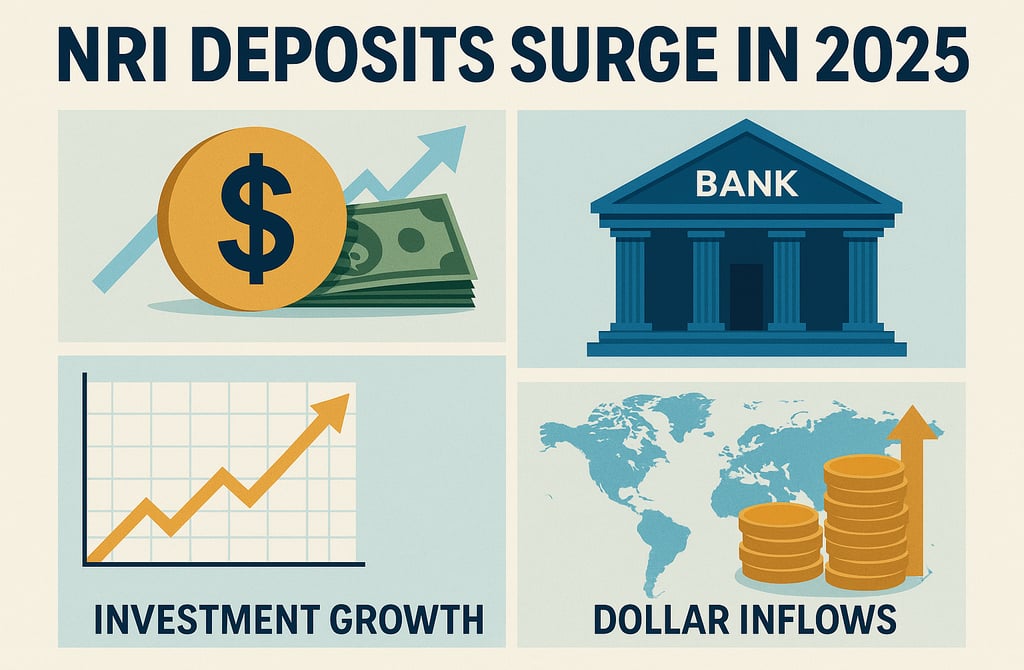NRI Bank Deposits 2025: Reasons, Benefits & Investment Outlook
Saurodeep
5/23/20252 min read


NRI Bank Deposits Surge in 2025: What’s Fueling the Inflow?
The Indian banking sector has witnessed a remarkable resurgence in Non-Resident Indian (NRI) deposits in 2025. With inflows hitting multi-year highs, this trend reflects growing global confidence in India’s financial system and a strategic shift in how expatriates manage wealth.
But what’s behind this sudden surge? Let’s explore the reasons and implications of this capital movement.
How Much Have NRI Deposits Grown?
As per RBI data released in Q1 2025:
Total NRI deposits crossed $150 billion, marking a sharp rise from $135 billion in 2024.
The surge is led primarily by FCNR (Foreign Currency Non-Resident) and NRE (Non-Resident External) accounts.
South India, the Gulf regions, and the US remain the top sources of inflows.
This increase is not just quantitative—it also signals a change in the confidence level NRIs hold in Indian markets and economic policies.
Key Reasons Behind the Surge
1.Favorable Interest Rate Differentials
Indian banks are offering higher interest rates (up to 7%) on NRI deposits compared to global rates which remain relatively low (1-3% in developed markets). This makes Indian bank accounts far more attractive for dollar, pound, or euro earners.
2.Stable Rupee & RBI’s Currency Management
The INR/USD exchange rate has shown increased resilience in 2025, bolstered by RBI’s effective interventions and robust forex reserves. This encourages NRIs to remit money without fear of rapid depreciation.
3.Liberalized Remittance Policies
Recent policy updates under FEMA (Foreign Exchange Management Act) now allow NRIs more flexibility in:
Repatriation of funds
Tax exemption on interest earned (under DTAA treaties)
Opening joint accounts with resident Indians
4.Rise in Real Estate & Investment Opportunities
NRI interest in Indian real estate—especially in Tier 1 cities and smart townships—has significantly risen. Many deposit funds in advance via NRE/FCNR accounts to lock in exchange rates and rates of return.
5.Global Uncertainty and Capital Reallocation
With geopolitical tensions, volatile US interest rate forecasts, and banking turmoil in some parts of Europe, many NRIs are diversifying away from Western banks toward safer, higher-yielding assets in India.
What Types of NRI Deposits Are Gaining?
NRE Accounts
Rupee-denominated
Repatriable + Tax-free interest
Gained ~9% YoY
FCNR Accounts
Foreign currency-denominated (USD, GBP, EUR)
Zero exchange rate risk
Gained ~15% YoY
NRO Accounts
For income earned in India (rent, dividends)
Saw marginal increase (mainly real estate-linked)
Impact on Indian Economy
Stronger forex reserves: Increased foreign deposits help the RBI buffer against global shocks.
Liquidity for banks: Indian banks benefit from greater deposit bases to fund infrastructure, lending, and credit expansion.
Improved Rupee stability: Sustained inflows reduce pressure on the INR in global markets.
What This Means for NRIs in 2025
If you’re an NRI, this is a prime time to:
Park idle foreign funds in high-interest Indian accounts
Explore rupee-hedged returns
Invest in long-term sectors (real estate, sovereign bonds, mutual funds)
Banks are also rolling out dedicated NRI services with 24/7 global support, seamless onboarding, and digital KYC to tap into this growing opportunity.
Conclusion
The NRI deposit surge in 2025 isn’t a short-term blip—it’s a reflection of India’s macroeconomic strength, regulatory foresight, and global trust. With attractive yields, improved policy clarity, and digital ease, NRIs are rediscovering India as a reliable hub for capital preservation and growth.
About One Solution
Quick Links
Contact Info
One Solution — Your trusted partner for financial success.
📍 F17, Grand Plaza, Paltan Bazar
Guwahati, Kamrup (M), Assam
India, Pin: 781008
📞 9650072280
© 2025 One Solution. All Rights Reserved.
